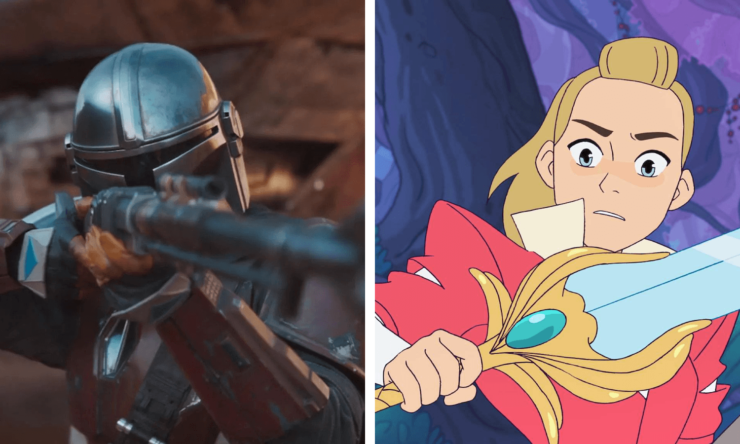Fanaticism has helped define our era. The popularity of unthinking, passionate adherence to a belief system over everything else, and the subsequent unwillingness to critically analyze the actions taken in the name of this ideology, has resulted in a series of unprecedented events in American politics and society. It has given rise to “alternate facts,” claims that anyone disagreeing with you is confirmation of your rightness, coverups of horrifying abuse scandals in some groups, and acts of international and domestic terrorism supported by others. This is a zealotry entirely different from feeling passionate about your religion, your philosophy, or your code—it is a self-fulfilling, all-consuming obsession that rejects reality and substitutes its own, that persecutes dissidents and demands blind faith and conformity from its adherents.
Given how much fanaticism has defined the first twenty-one years of the twenty-first century, it’s unsurprising that it pops up often in speculative fiction, or that some of the most popular and acclaimed media in this genre would shine a spotlight on it…and on how we escape this trap of unreality. Two of the most interesting TV series to tackle fanaticism in 2020 are She-Ra and the Princesses of Power, and The Mandalorian.
[Spoilers for both She-Ra and the Princesses of Power and The Mandalorian]
I do want to start by emphasizing that these two shows tackle very different forms of fanaticism and its close adherent, fundamentalism. The Way of the Mandalore in The Mandalorian is both culture and religion for a dispossessed community, and is interpreted and practiced in many different ways amongst the larger Mandalorian diaspora. Though other Mandalorians accuse the titular Mandalorian, Din Djardin, of being in a specific cult called “the Children of the Watch,” the Way of the Mandalore existed before his covert interpreted it, and there appear to be as many different interpretations of “The Way” as there are Mandalorians. Mandalorians also do not demand all other people join in their belief system; just respect it.
The Horde in She-Ra is a cult of personality around one charismatic leader, Horde Prime. Prime makes clones of himself, and can both take over their bodies and read their minds through what the clones call the “hive mind.” The hive mind is in reality a neural network, and each being connected to the network does so thanks to a microchip in their necks that eventually fuses with their nervous systems. By the most literal definition, it is an invented religion: one created and advanced by Horde Prime’s scientific prowess, and one that centers on the belief that Horde Prime is more-or-less a god, a false story that Horde Prime created and takes pains to protect. This particularly fanatical group, the Horde, sustains itself by conquest, and is decidedly not open to interpretation. Those who disagree or who assert their individuality are forcibly “reborn” in Horde Prime’s image.
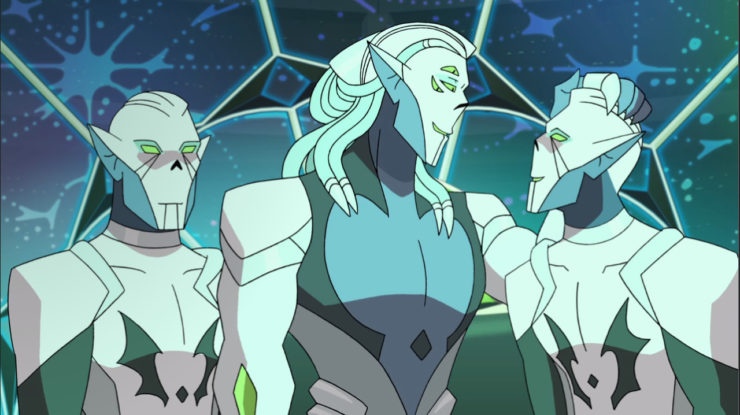
We see this first in episode thirteen of season four, “Destiny, Part Two.” Horde Prime discovers his lost clone, Hordak, has lost connection with the hive mind, and this caused Hordak to give himself a name, try to take over a planet, and later declare to Horde Prime, “I have bent its people to my will!” Hordak’s will that is—not Horde Prime’s. This assertion of individuality is antithetical to Horde Prime’s ideology; the clones have no individual will, purpose, or personality. They are empty vessels in which Horde Prime can pour his own consciousness at will. Horde Prime declares, “I have made you in my image, but you have become an abomination! You must be reborn!” This is rhetoric straight out of evangelical Christianity—the talk of rebirth and abomination, and a sci-fi spin on the idea that man is made in God’s image. This is made even clearer when antagonist-cum-deuteragonist Catra later finds Hordak and calls him by name in episode three of season five, “Corridors.”
For most of the series, Hordak has been on his own, entirely cut off from the rest of the Horde in the empty dimension of Despondos. Though he spoke often of the Horde, he was the primary antagonist and each season saw him growing farther from the Horde, connecting with his lab partner Entrapta, and creating his own tech and his own kingdom. As soon as he sets foot on Horde Prime’s ship he is forcibly knocked out and “reprogrammed.” It is unclear if Hordak actually wanted this return to the hive mind, and this separation from his individuality, but the first time we see him in this episode, he has lost the armor he created with Entrapta, and his colored hair returns to the same white as all the other clones. This conformity seems something imposed from without, and perhaps imperfectly internally accepted. When Catra calls him by name, Hordak replies, repressively, “It is wrong to have a name. Prime’s chosen servants are but parts of the whole,” and later undergoes what appears to be a form of public confession before Prime and a congregation of other clones. Hordak gets on his knees to say, “She…gave me a name. Forgive me brother. Please…take this affliction from me.” Having been so publicly corrected at the end of season four, Hordak spends the first half of season five trying desperately to assimilate into the pack again. Horde Prime always “grants” this. In an act that seems inspired by an adult baptismal ceremony from certain strains of American Evangelical Christianity, the clones chant, “Cast out the shadows!” as Hordak steps into a pool, and then, once he is in it and (in a sci-fi twist) being shocked with electricity, the clones chant “All beings must suffer to become pure!”
The echoes of evangelical Christianity are intentional. Showrunner Noelle Stevenson told Polygon that she and her crew drew inspiration from megachurches when designing Horde Prime’s ship, though in that same interview she points out that Horde Prime was specifically modeled on cult leaders—specifically suicide cult leaders. Horde Prime has set himself up not as a representative of God, but as a god, a belief system on an invented ideology that equates unity with him, through the hive mind, with bringing “peace” to the universe. It is a peace that comes not from understanding, but suppression. Those who resist are destroyed. How then, does one free people from such a cult?
By first disconnecting them from it. The hive mind reinforces the tenets of the Horde and extinguishes all hope of independent thought. The journey towards recovery only begins when the microchipped characters break or damage their chips, and stop “drinking the Kool-Aid,” so to speak… or as my favorite side character, Wrong Hordak would call it, drinking the “nutrient-rich amniotic fluid!”
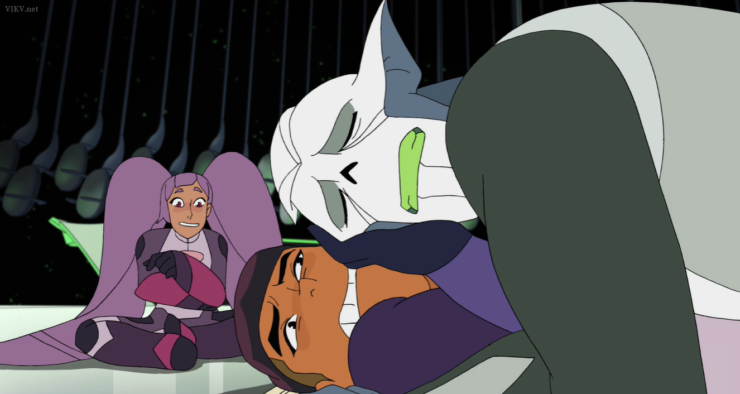
Wrong Hordak is a clone accidentally disconnected from the hive mind by heroes Bow and Entrapta, and more-or-less adopted by the pair. When he connects to real data about the Horde on the magical, abandoned planet Krytis, he learns for the first time that that Horde Prime is not all-powerful, but a liar who holds his followers in check through force, charisma, and faulty programming, and that objective fact does not support Horde Prime’s rhetoric. Wrong Hordak then has what Entrapa cheerfully describes as “an existential crisis.” (A scene perhaps now familiar to Americans who have been following how QAnon adherents reacted to Joe Biden’s inauguration as president.) It isn’t just that he’s learned he’s part of a cult based on disinformation; he has lost his entire sense of identity. When Entrapa tells the others that, “Wrong Hordak has begun to question the meaning of life,” but she can handle it, we can overhear Wrong Hordak wail, “Who am I if not an exalted brother of Prime?” But Entrapta does handle it. Through her offscreen support and probable discussion of how data never lies, Wrong Hordak ends the episode wishing to tell his fellow clones that they have been lied to and that they should rise up against the “false ruler” Horde Prime.
However, as the show warns—and as in the case of QAnon believers and other members of cults—presenting someone with facts that contradict their belief system doesn’t immediately or always work. Once you help remove someone from the cult’s main forms of communication or its message, you must offer them support in reestablishing their identity outside of the cult. This may be more clearly seen in the case of Catra. She escapes the Horde only when our main heroine Adora damages the microchip implanted in Catra’s neck—thus cutting Catra off from essentially a live feed of cult programming—and then reaches out to Catra and reminds her of who she is, and who she was before she was microchipped. Adora then provides both emotional support (in the reaffirmation of their friendship) and physical support (in that she physically carries Catra off Horde Prime’s ship) before helping Catra seek out appropriate medical attention, and then helping her make healthier friendships.
Buy the Book


A Psalm for the Wild-Built
This advice echoes what Steven Hassan, founder of the Freedom of Mind Resource Center, and a psychologist specializing in cults, suggests in a recent Op-Ed for NBC on how to save a loved one from the cult of QAnon. “Appeal to their sense of integrity, reason and conscience,” he writes, before advising the reader to suggest alternate, more reliable sources of information, and to act with “a team of trusted allies.” You can see this approach at work—and the repeated difficulties cult members have in leaving the cult—in Leah Remini: Scientology and Its Aftermath, an A&E documentary series. Each episode follows how an individual got into Scientology and their struggles getting out of it again. Helping someone step away from fanaticism is a process that repeats, rather than a one and done deal.
These steps—try and cut off programming from the cult, provide fact and data-based refutation of the cult’s ideology, reestablish a personal connection with a specific person with the help of a group, and offering support when they at last exit it—gets repeated in different iterations at the climax, when half the main cast are inducted into the Horde via microchip. In the last episode, we even see this applied in a slightly different version, to the main character of the series, Adora. In the first season, Adora successfully escaped the Horde thanks to physically leaving the Fright Zone (i.e. land controlled by the Horde) seeing the way other people in Etheria lived, realizing she had been lied to, and striking up a friendship with Bow and Glimmer, who then offered her physical and emotional support.
However, escape from a cult is an ongoing struggle. Though Adora fights against the Horde, she still believes what Horde (or at least what member Shadoweaver) taught her: that she, Adora, must always be the one who sacrifices. That there is no future for her, outside of the Horde. When she is on the verge of death in episode thirteen of season five, Horde Prime even interrupts the vision of Adora’s dying wish—herself in a relationship with Catra, living with her best friends Bow and Glimmer—by saying there is no future for her. Adora almost gives in until Catra cries out for her, reminding Adora that she is not the kind of person who ever gives up, and confessing, “Don’t you get it? I love you!”
This pulls Adora out of her mental trap. She comes to, asking, “You love me?” and after confessing, “I love you too,” and kissing Catra, Adora finds the strength to operate the failsafe that will destroy the Heart of Etheria, the weapon Horde Prime has seized and hopes to deploy on his own behalf. Queer love and friendship literally save the day. The series ends, notably, on the word, “together.” That is what the whole series has been driving towards; the idea that the bonds you create with other people are what save you, and that any just society is built on celebration of difference, friendship, and mutual aid. In other words: a found family.
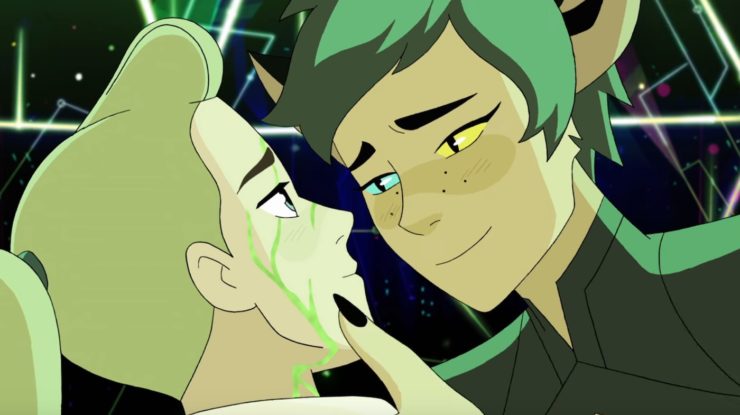
In The Mandalorian, found family is almost a tenant of faith in the Madalorian creed. In the last episode of the first series, the Armorer explains that Mandalorians cannot leave abandoned children—such as Grogu, better known as Baby Yoda. “A foundling is in your care,” the Armorer tells Din Djardin. “By creed, until it is of age or reunited with its own kind, you are as its father.” This same creed is the reason why Din himself is a Mandalorian. Mandalorians rescued him after battle droids killed his family, and raised him as their own. The echoed entrance into Mandalorian life is powerful. The Way is not, like Horde ideology, a means of entrapment, but of liberation and safety. Mandalorian culture provides a safe home for both Din and Grogu. The first season revolves around Din Djarin’s affection for and responsibility for Grogu as they make friends across the galaxy—but centers their relationship within Din’s deeply held beliefs. He must care for foundlings, he must follow The Way, and he must never remove his helmet in front of anyone else.
In the second season, Din searches not only for Grogu’s kind, but his own. The other Mandalorians he finds, however, do not have the same understanding of their creed. In chapter eleven, “The Heiress,” Din meets other Madalorians in battle (as he expects) but as soon as the battle ends, they take off their helmets. Din is horrified and, after demanding to know how the leader, Bo-Katan Kryze, got her armor, exclaims, “You do not cover your face. You are not Mandalorian.”
One of Bo-Katan’s lieutenants immediately mutters, “He’s one of them.”
After Bo-Katan establishes that she is a Mandalorian by birth (born on Mandalore, to two Mandalorian parents) and by action (she fought in the Great Purge of Mandalore) and by armor (it was in her family for three generations), and is, in fact, considered to be the rightful ruler of Madalore, Bo-Katan tells Din, “You are a Child of the Watch. The Children of the Watch are a cult that broke away from Mandalorian society. Their goal is to reestablish the ancient way.”
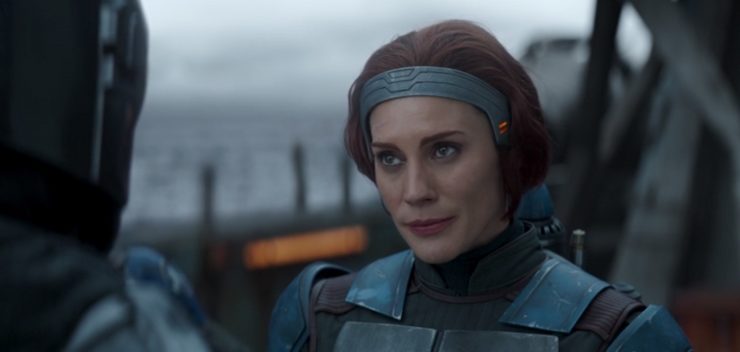
To this Din angrily retorts that there is only one way, and takes off—as it would any cult member whose beliefs have been challenged. However, Din’s reaction to the news he was raised in a cult is very different from Catra’s. It’s much more like Adora’s.
Upon being confronted with a completely different means of understanding and interacting with the world, Din is shaken and eventually convinced by it. It seems clear, from his initial response to Bo-Katan, and from what we saw in the first season, that he had never met any other Mandalorians outside of his covert/cult. All he knows is their fundamentalist interpretation of the Way. However, after he works with Bo-Katan and the other Madalorians to capture an Imperial cruiser, he begins to shift away from the strict fundamentalism in which he was raised to a more nuanced and complicated exploration of his beliefs. He later acknowledges the other Mandalorians as Mandalorians, and recognizes Bo-Katan’s claim to the throne of Mandalore. When he runs into Boba Fett—whom Bo-Katan does not consider a Mandalorian because he is a clone, not a foundling or a biological child—Din recognizes him as a fellow Mandalorian and returns Fett’s armor: the outward and perhaps most valued symbol of belonging within the Mandalorian diaspora.
The Children of the Watch differs from the Horde, or from QAnon or Scientology, by being a cult formed in response to the loss of a homeworld, and founded on general principles all other Mandalorans accept—though interpret very differently. Din’s journey is therefore less about leaving a cult founded on complete fabrications, and leaving one founded on religious fundamentalism. It is about determining the best way to act on his beliefs, rather than realizing he’s believing outright lies.
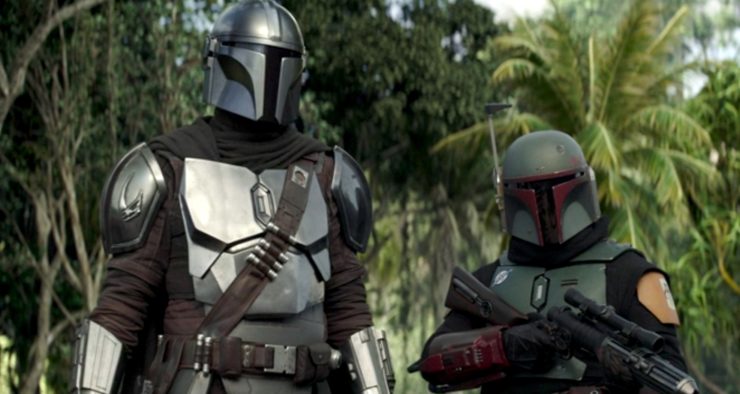
In an interesting narrative flip of his, “You do not cover your face. You are not a Mandalorian,” Din’s journey begins with changing understanding of who is a Mandalorian, and ends with his changing understanding of how one should act as a Mandalorian. Does being a Mandalorian, someone whose armor and weapons are as much a part of his faith and culture as the acceptance and love of foundling, mean you must adhere zealously to these precepts? Does it mean always wearing your helmet and always keeping a foundling with you—even when their needs are beyond what you can supply?
In the finale of the first season, Din takes off his helmet before the droid IG-11 because Din has suffered a bad head injury, and because the droid is “not a living creature” and therefore an exception to the rule. It is treated by the show as a moment of profound vulnerability, as an action taken out of necessity. The first time Din raises his helmet in the second series, one can still argue it’s done out of necessity and through a loophole. Din lifts his helmet to drink soup in front of Grogu, a member of his family as defined by the head of his cult. Then, when Grogu has been kidnapped by Moff Gideon, Din takes off his helmet entirely in order to use an Empire scanner and find Grogu again. One could once again argue necessity but it also signals a values shift. Din has consciously decided that it is more important to protect a foundling in his care than to adhere to the creed’s requirement to never take off a helmet.
The third time Din takes off his helmet, it is clear his understanding of the Way has powerfully shifted thanks to his found family.
It is a deliberate unmasking. Din has finally fulfilled his season-long quest to return Grogu to his kind: the Jedi. “That’s who you belong with, he’s one of your kind,” Din tells Grogu, as Luke Skywalker swoops in to single-handedly (pun intended) save the day. “I’ll see you again, I promise.” Grogu reaches up to touch Din’s helmet, at which point Din takes it off entirely, to answer affirmatively to the implied request and let Grogu actually touch his face.
Though Din does it specifically for Grogu, his child according to his cult’s creed, he also does it in front of a fair number of other people. The people who risked their lives to help reunite him with his child, in fact: Bo-Katan and the other Mandalorians who work with her, but also a bounty-hunter and a Marshal he befriended in the course of his travels. The implication is that just as Grogu has found his kind, so has Din. He is among part of the family he created while searching for one—a family that managed to defeat an entire Imperial Light Cruiser full of battle droids programmed by fanatical mastermind Moff Gideon. This rag-tag found family managed to defeat Empire-based fanaticism though combining their skills and working towards a common goal, and also helped Din leave behind the strict rules of his cult to engage more critically with the idea of what it means to be a Mandalorian.
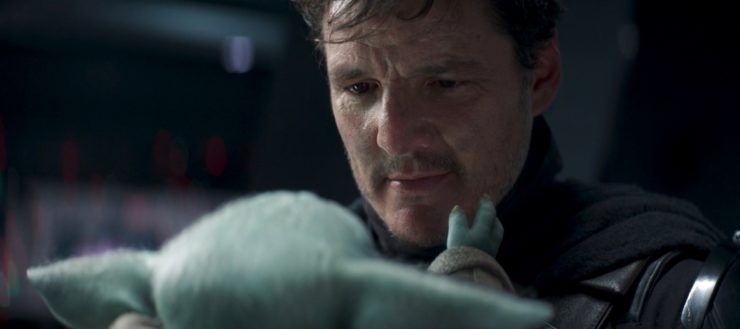
Din’s journey away from fundamentalism towards a more personalized interpretation of his faith echoes the pattern set up in She-Ra, and the standard psychological response to leaving a cult, but offers a different ending based on the differences in the cult under question. After Din sees how other people live— or in this case, interpret the Way of the Mandalore—he defensively resists this attack on his central beliefs. Others help remind him of other parts of his identity (a frog couple he reunited recognize him as a helpful pilot and father to Grogu; the other Mandalorians recognize his skills as a fighter; his friends on Nevarro remind him that he is a bounty hunter) and all of the friends he has made across the galaxy reaffirm his identity as a good man, a talented fighter, and a devoted father to Grogu. In fact, when Grogu is kidnapped, almost every main character on the show immediately jumps into hyperspace to help rescue him. This trusted team questions Din, offers him different ways of seeing the world or understanding his faith, and gives him space to act according to his conscience. And, in the end, Din stops defining himself as a Child of the Watch, who belongs only as long as he keeps his helmet on, but as a father trying to do the best for his child, even if it means a temporary separation.
In both series, asserting your identity, particularly how you define yourself in relation to people unrelated to you by blood but with whom you have strong bonds, is a radical and heroic act. The fact that the hero’s arc is away from fanaticism to a more nuanced and compassionate understanding of themselves and those around them is a hallmark of our era—as is the fact that the end of the cult’s grip on the main character does not mean an immediate happy-ever-after. There is still work to do, still conflicts to resolve, still greater problems—like returning magic to the galaxy, or settling who is the rightful ruler of Mandalore—to work out. But because of the families Adora and Din found in the course of their travels, they are in a better position to do this work, and to dismantle the damage done by fanaticism, Horde or Imperial. This acknowledgement of larger-scale problems in the midst of a weary optimism is likewise a hallmark of our time. Certain leaders may be gone, certain groups deplatformed or depowered but we know if history will not outright repeat, it will rhyme. We may not know who the next QAnon will be, but we do know that more conspiracy theory-based cults will rise up. But these shows posit that the dragon can be slain, and those trapped inside its cave rescued. Found families reflect a microcosm of an ideal society: one where all are valued for their differences, and these differences are understood and accepted as necessary to accomplish shared goals. In this unity, in this ability to not just see but understand how diverse viewpoints strengthen our understanding, in this acceptance of non-traditional bonds as some of the strongest, fanaticism cannot flourish.
Elyse Martin is a Chinese-American Smith College graduate who lives in Washington DC with her husband and two cats. She writes reviews for Publisher’s Weekly, and her essays and humor pieces have appeared in The Toast, Electric Literature, Perspectives on History, The Bias, Entropy Magazine, and Smithsonian Magazine. She spends most of her time writing and making atrocious puns—sometimes simultaneously—and tweets @champs_elyse. She’s at work on several novels.










